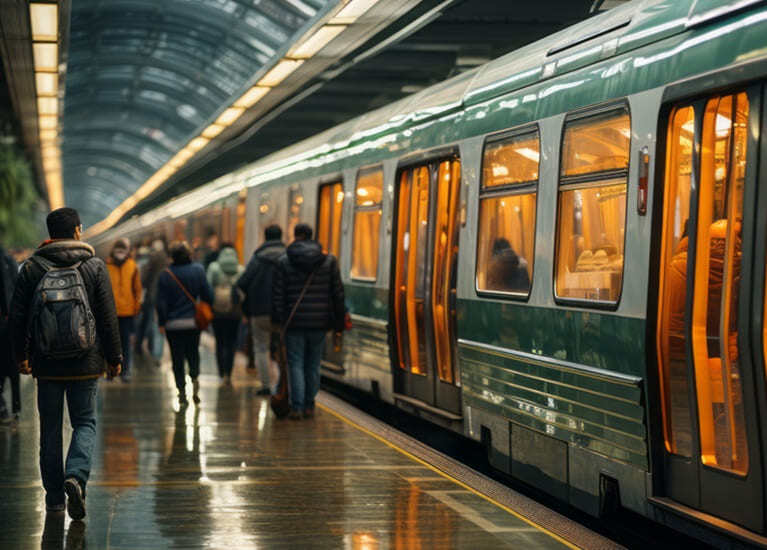Delays, overcrowding, and insufficient routes—every day, passengers encounter these and many more challenges that make them hesitant to choose public transport. To counter this, public transportation systems are now using artificial intelligence (AI) as an effective solution to optimize route planning, predict disruptions, and deliver timely information. This blog explores how combining AI, advanced analytics, and crowd-sourced data can transform public transit into a more reliable and user-friendly network, ultimately restoring confidence in urban mobility.
The transformative power of AI technology
AI’s capability to analyze large datasets and anticipate user behavior is reshaping transportation. By integrating data from passenger apps and journey planning systems, AI helps streamline route planning and traffic management, reducing commute times and enhancing service reliability.
1. Crowd-sourced data for managing disruptions
Crowd-sourced data helps manage unexpected disruptions, providing real-time, ground-level insights that help transportation providers promptly address delays, cancellations, and reroutes. This transparent method not only provides live notifications and proactive recommendations to travelers but also allows operators to reward users, strengthening trust in public transport services.
Many solutions are now being developed with the help of AI, which utilizes crowd-sourced data to provide information on disruptions in real time. For example, our AI-driven platform, Journey Watch, lets providers manage disruptions at scale.
Nagarro’s Journey Watch: A crowd-sourced data platform for disruption management
Nagarro’s Journey Watch leverages traveler-shared data and operator insights to deliver real-time notifications on delays, cancellations, or reroutes. It also streamlines communication between passengers and operators, including delegation to trusted passenger groups when necessary.
.png?width=750&height=397&name=Journey%20Watch%20Dashboard_AI-powered%20ground%20transportation%20platform_%20(1).png) Fig 1: Dashboard of Journey Watch
Fig 1: Dashboard of Journey Watch
This solution is built similarly to the Waze app where users share insights into what happens on the ground and get mutual benefits. This information is also relevant for public transport operators.
2. Personalization for enhanced user experience
Modern mobility apps now go beyond basic trip planning. With AI-enhanced solutions, these apps are able to learn all about user behavior and offer personalized recommendations, suggest alternative routes during disruptions, and provide timely reminders for ticket purchases. Arriva, a leading European passenger transport operator, partnered with Nagarro to develop an AI-powered travel assistant, ViTA (Very Intelligent Travel Assistant), that personalizes travel experiences as per individual needs.
ViTA: For personalized travel recommendations
ViTA, a solution of Arriva UK Trains, consolidates travel data to streamline journey planning, boost ticket sales, and improve operational efficiency—all while tailoring the travel experience to individual needs.

Fig 2: A customer interacting with ViTA, Arriva’s Travel Assistant
ViTA utilizes AI-enhanced trip planners to transform everyday travel into a personalized service. ViTA helps streamline journey planning and also:
• offers real-time journey and fare information,
• provides links to book services as per need with just a click,
• customizes travel options based on user preferences, and,
• displays accommodation recommendations near travel points.
3. Enhancing operations through predictive analysis
Mobility solutions today heavily rely on data. Vast amounts of data are being produced by Mobility-as-a-Service (MaaS) platforms (such as schedules and real-time vehicle locations) which AI then converts into actionable insights.
A vital aspect of AI insights is predictive analysis, which helps foresee and optimize service schedules and passenger flows, reducing costs and enhancing operational planning. In turn, cities benefit from this high-quality, near-real-time crowd-sourced data which helps them enhance and refine their transit operations.
4. Empowering employees with chatbots
AI’s role extends beyond passenger services. By analyzing historical and real-time data, AI tools enable operators to detect anomalies—such as accidents or maintenance issues—and adjust services swiftly. These analytics, potentially enhanced by computer vision and edge computing, support more informed decision-making across the board, including the staff who can interact with internal systems through conversational interfaces. One such solution is Nagarro’s Staff Companion.
Staff Companion by Nagarro: AI-led conversational assistant
The Staff Companion solution simplifies internal communication for station agents and train conductors by providing a conversational interface to access various systems. It streamlines tasks like reporting delays, incidents, or equipment issues, while features such as reminder setting and natural speech input boost operational efficiency and staff accessibility.


Fig 3: Interfaces of Staff Companion
Why quality is the key aspect of your data
High-quality, crowd-sourced data is the foundation of effective AI applications. Structuring accurate passenger information into efficient learning loops enables AI to manage disruptions, optimize routes, and personalize services. Additionally, it is vital to design AI systems that balance performance with sustainability—minimizing environmental impact by reducing unnecessary data processing. Integrating trusted information from existing APIs and databases further ensures reliable outputs without overburdening computational resources.
The future of AI in transportation
Task-specific optimization with tiny models
Over the next few years, transportation providers are expected to transition towards specialized, task-specific smaller models embedded within systems like ticketing platforms, navigation tools, and maintenance applications. By focusing on task-specific optimization, these smaller models will further reduce computational costs while maintaining accuracy, even in environments with limited connectivity.
These tiny models will interact to resolve local issues and, over time, address broader transportation challenges. Building these models right away ensures that the essential components for future scalability are in place. Specialized models tackle reliability challenges by delivering prompt responses, even when connectivity is limited. They perform specific, repetitive tasks, demonstrating that effective solutions can be achieved without relying on vast amounts of data. These tasks include:
- providing station information,
- counting passengers, or,
- detecting defects.
Autonomous decision-making with Agentic AI
The world is quickly evolving towards Agentic AI, ushering in a fresh era of intelligent, data & AI-driven efficiency and productivity. Agentic AI exhibits higher degrees of autonomy and self-improvement capabilities without any human intervention (in comparison to tiny models or AI agents that follow pre-defined rules and have very little autonomy). As per an Emergen Research report, the Agentic AI market was valued at USD 30.9 billion in 2024 and is projected to grow to USD 367.68 billion in 2033, a whooping growth of 31%.
Agentic AI will drive innovation and redefine the landscape for public transportation as well, with effective route planning, safer roads, and better passenger experiences. Most importantly, Agentic AI can play a crucial role in making transportation cleaner and sustainable. Apart from these benefits, Agentic AI is being rapidly leveraged to power autonomous vehicles and this may be implemented for mass transportation very soon.
Conclusion
The integration of AI in public transportation is still being done by various transport providers across the globe and is set to shape the future of urban mobility. With several real-world AI-led examples like the ones mentioned above, commuters, transportation staff, as well as decision-makers are being empowered to streamline mass transit. From personalized travel experiences to enhanced operational efficiency, AI-driven insights are revolutionizing public transport, making it more accessible, resilient, and sustainable. Also, the predictable transition from traditional AI models to Agentic AI in the future will ensure smarter, more efficient, and safer transit systems.





